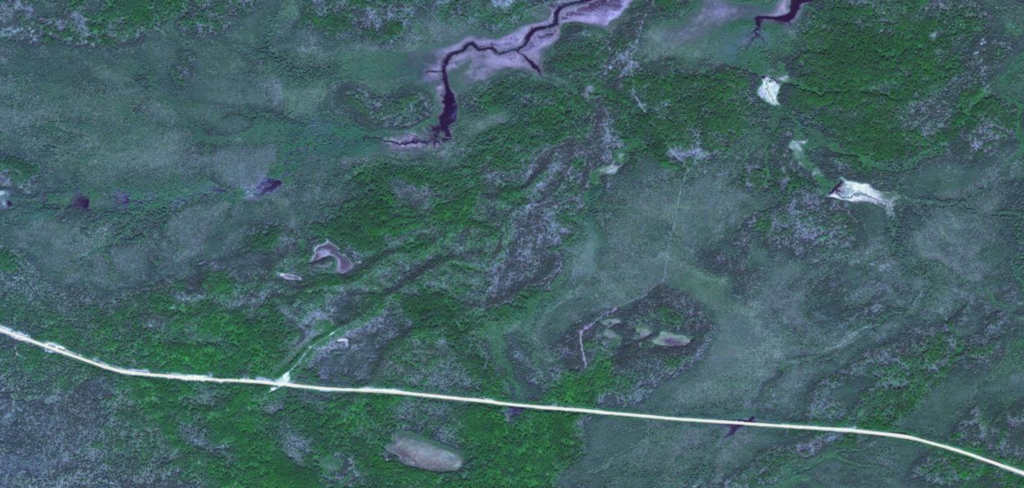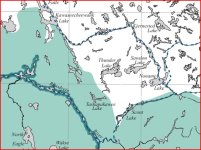Thanks for the clarification of where the confusion came from. I have always wondered why the old map shows two paths running parallel and very close together for 2100 meters. As you would have seen, moving to the side on the northern parts would not have changed the steep climbs to a bog walk alternative. I hope you have time to E-mail the park and inform them of the trail being flagged improperly. Wintertime use??
I will be awaiting your info on the Sakakoneekum portage as I plan on getting up there in the next few years. I know the area gets some use but details are hard to come by. Howard Holtman, his story prompted me to drive a little further to Woodland Caribou.
I finally have the time and inclination to address the Sakakoneekum portage. There is a story attached that I wanted to tell because it involves those who keep the portage open. I kept a journal on this trip (there was no one to talk to for many days at a stretch). So, the Sakakoneekum...
The story begins at Artery lake where I was camped on the island in the south part of the lake, the first decent place to stop after the portage. I woke at 4:30 as usual because it is light, and light wakes me up. My left knee was in a fair amount of pain after the inward hyperextension in the middle of the last portage. I kneeled down with the large pack on, moved to the side and put too much stress on the tendons of my inner knee. It buckled, I fell, and it moved back into place. No audible pops or visible bruising, just some swelling. Close call, but I was ok. After this incident I was really careful about where and how I put my feet.
I was going to take a day off, but the campsite had at tree across to and someone had camped there in the winter and left a fire ring with 10 tin cans in it. My subconscience told me to leave and there was a wind from the south west, so I assessed my physical condition and thought that I could easily ride the wind to the pictographs at the north west part of the lake. Reasonable. So that is what I did, and enjoyed a free ride during an awesome day to the most amazing pictographs that I had ever seen. The wind, however had picked up, moved to more westerly, and threatened to get harsh. So I headed west into the wind, to where the Bloodvein drains the lake. It was a push when the wind picked up, but I made it to the portage where a lodge is located. As I approached the lodge, an American came out to the dock and said, " hey stop in here and have some food! We have lots, and don't say no!" Ok then. I had no problem answering questions and talking and accepting their hospitality. They even carried my gear across the portage. Thanks guys! I was feeling really good after that and my intention of taking a day off travel and the sore knee was at the back of my mind.
It started to rain as I began to paddle the Bloodvein, but my spirits were high. After I had travelled about 2 hours west on the river, I got out at a short portage, did one trip of my double, and what appears around the bend coming up the river, but a canoe with 2 guys coming up the river against the current. As they started to unload, I said to them, when they realized that I was there, "hey guys, the current is going THAT way". They chuckled and introduced themselves. They were Fred Marks and Jay Timmerman. Now, I had no idea who Fred and Jay were, but they told me that they were headed to Albany, which I thought was in New York, but apparently that day on the Bloodvein Albany was at James Bay, and the destination was 1,000 miles from their put-in at Bloodvein village. I learned when I got home that there is an Albany river that empties into James Bay and also a Fort Albany near the coast. I suppose that is why Fred said to me "Well, that is where Albany is, at James bay," when I made New York comments. It was getting late and Fred told me that they had a 12 hour day the previous, but we talked for about 20 minutes. Apparently they had done a previous trip that they wrote a book about.
http://www.amazon.com/Far-Distant-E...d=1435880859&sr=1-1&keywords=far+distant+echo
And Fred was the outfitter that had worked in Bissett with the Boy Scouts of America, and Jay had worked for 10 years as a guide for the scouts from Bissett. Noe Jay mentioned to me that he was the one who had talked the scouts' management into flying the young scouts into the north country instead of making them do the Obukowin portages.
I will post this and carry on so the computer doesn't eat everything.






